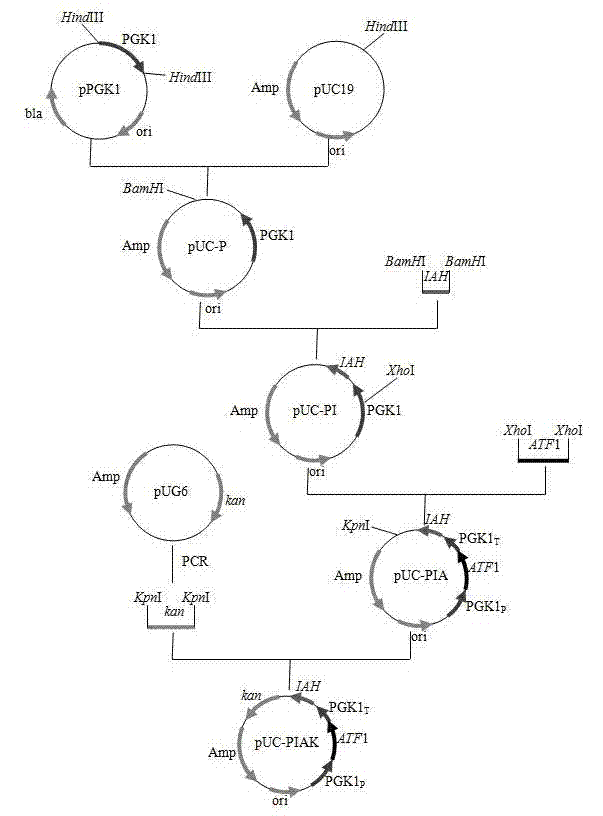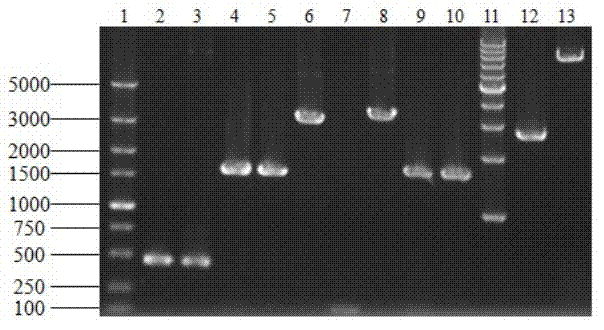Saccharomyces cerevisiae genetic engineering bacteria with high ester yield and construction method thereof
A technology of genetically engineered bacteria and Saccharomyces cerevisiae, which is applied in the breeding of industrial microorganisms, the genetically engineered bacteria of Saccharomyces cerevisiae with high ester production and its construction field, can solve the problems of poor quality of finished wine, low wine yield of raw materials, and low content of ester aroma substances.
- Summary
- Abstract
- Description
- Claims
- Application Information
AI Technical Summary
Problems solved by technology
Method used
Image
Examples
Embodiment 1
[0045] Embodiment 1: Construction of high-yielding Saccharomyces cerevisiae genetically engineered bacteria
[0046] 1) Construction of pUC19-PIAK plasmid:
[0047] Digest the pPGK1 plasmid with Hind III to release a PGK1 fragment of about 1.8 kb in size; digest the vector pUC19 with Hind III; use T 4 DNA ligase ligated PGK1 / Hind III and pUC19 / Hind III to form plasmid pUC-P; BamH I digested IAH1 homologous fragment and plasmid pUC-P respectively; 4 DNA ligase was connected to construct plasmid pUC-PI; Xho I digested ATF1 gene and plasmid pUC-PI respectively; 4 DNA ligase ligated to form plasmid pUC-PIA. Using pUC-PIA as a template, design corresponding primers according to the sequences of PGK1 and ATF1 to verify the direction of ATF1; KpnI digests Kan gene and plasmid pUC-PIA respectively; 4 DNA ligase connection to form plasmid pUC-PIAK, the construction process is as follows figure 1 shown. figure 2 It is the verification electropherogram of the pUC-PIAK plasmid: wher...
Embodiment 2
[0063] Embodiment 2: Simulation rice wine fermentation experiment
[0064] 1) Refer to the fermentation process route Figure 7 .
[0065] 2) Process conditions: rice soaking conditions: 25-30°C, soaking for 72 hours; cooking conditions: steaming at atmospheric pressure for about 30 minutes, with uniform grains and no white inside; pre-fermentation conditions: 28°C, 5 days.
[0066] 3) Ingredients: japonica rice: 100g; cooked wheat koji: 10g; water: 105ml, the water includes 60ml of clear water, 45ml of slurry water, excluding soaked rice and steamed rice for water absorption; inoculum size: 10% (20mL).
[0067] Saccharomyces cerevisiae CGMCC No 2.1525) and its haploids (type a and α) were subjected to semi-solid Fermentation experiment; oscillate and weigh every 12 hours during the fermentation period, and record the weight loss; after the fermentation is over, stop the cultivation and weigh; measure the residual sugar concentration, alcohol volume fraction and main aroma c...
Embodiment 3
[0072] Embodiment 3: simulated liquor fermentation experiment
[0073] The ester-producing properties of alcohol ADY, Saccharomyces cerevisiae receptor strain and S. cerevisiae engineered strain were compared by continuous residue fermentation method. Test method: raw material: distiller's grains=1:2.5, rice husk is 20% of raw material, and the total weight of each pot is about 300g. The added amount of glucoamylase is 250U / ml, and the added amount of alcohol ADY and rice wine yeast is 1.2%. Enter the altar to ferment for 7 days. After the fermentation, the residual starch, alcohol volume fraction and main aroma component content of each jar were measured, and its comprehensive performance was characterized by fermentation capacity, residual sugar concentration and product production. The results are shown in Table 2.
[0074] Table 2 Liquor fermentation performance of alcohol ADY, Saccharomyces cerevisiae receptor strain and Saccharomyces cerevisiae engineered strain
[00...
PUM
 Login to View More
Login to View More Abstract
Description
Claims
Application Information
 Login to View More
Login to View More - R&D
- Intellectual Property
- Life Sciences
- Materials
- Tech Scout
- Unparalleled Data Quality
- Higher Quality Content
- 60% Fewer Hallucinations
Browse by: Latest US Patents, China's latest patents, Technical Efficacy Thesaurus, Application Domain, Technology Topic, Popular Technical Reports.
© 2025 PatSnap. All rights reserved.Legal|Privacy policy|Modern Slavery Act Transparency Statement|Sitemap|About US| Contact US: help@patsnap.com



